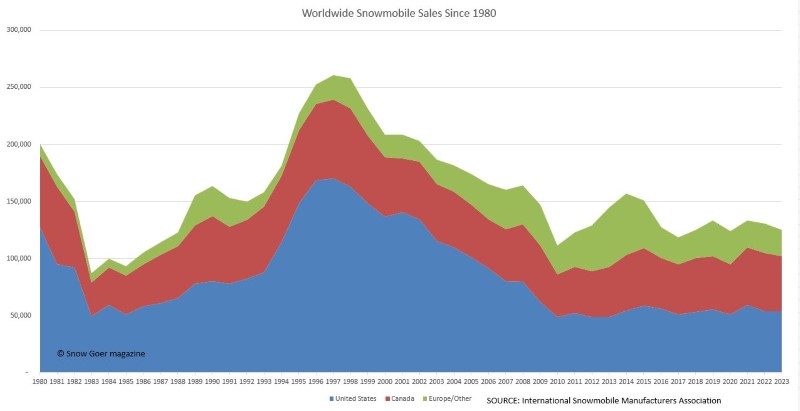
New snowmobile sales were flat in the U.S., decreased slightly in Canada and increased notably in some key Scandinavian countries in the just-completed season.
Sales in Russia, meanwhile, were shut off due to trade embargoes following that country’s invasion of Ukraine. That pulled down the total worldwide snowmobile market figures.
Those were just some of the highlights released recently by the International Snowmobile Manufacturers Association (ISMA). ISMA President Ed Klim unveils the sales figures each June at the International Snowmobile Congress event, held recently in Moline, Illinois.
Annual sales in the snowmobile market reflect “new” models sold and delivered to customers between May 1 the previous year through April 30 of the current year. They include new/current model machines (in this case, 2023 models) plus recent, non-current new models that were still in inventory at dealerships.
The “and delivered” part is key. The sales figures do not include spring orders for the following year’s snowmobile. Sales only count once a new owner takes possession of the machine.
Overall, worldwide sales of new snowmobiles dropped by 4.5 percent to 124,769 units, largely due to limited build-quantities by the snowmobile manufacturers plus the complete shutdown of sales in Russia. Also, supply chain issues in recent year caused many orders have been cancelled or delivered very late.
U.S. Snowmobile Sales Figures
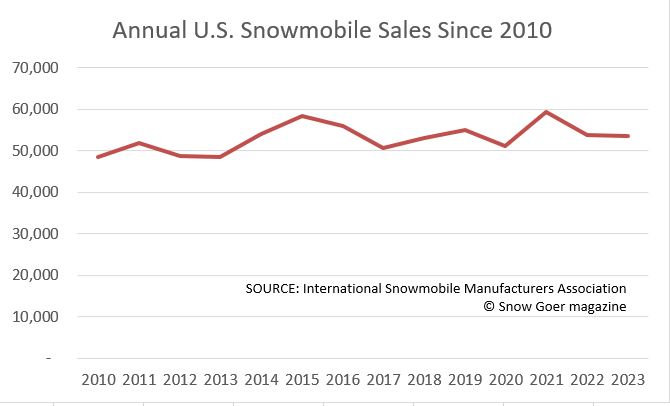
New snowmobile sales in the 2023 season in the U.S. decreased by a half percent, according to ISMA data. A total of 53,553 units were sold compared to 53,821 units the previous year – a drop of 268 units.
Looking at it regionally, sales increased 5.6 percent in the Midwest and 1.8 percent in the West. They took a 13 percent dip in the Northeast, where a sub-par winter was experienced. Anecdotally, dealers have told Snow Goer that units originally planned for Eastern dealers were redeployed elsewhere as winter unfurled to reflect the reality of the weather experienced. Long term, the Northeast remains a per part of the market.
Last year, the Midwest accounted for 41 percent of sales, the West 35 percent and the East 24 percent, ISMA reported.
The U.S. numbers fall in line rather closely with the sport’s 10-year sales average. Registrations of new and used snowmobiles crept up slightly in the U.S., to 1,266,981 units last winter compared to 1,264,097 the previous winter.
Canadian Snowmobile Sales Figures
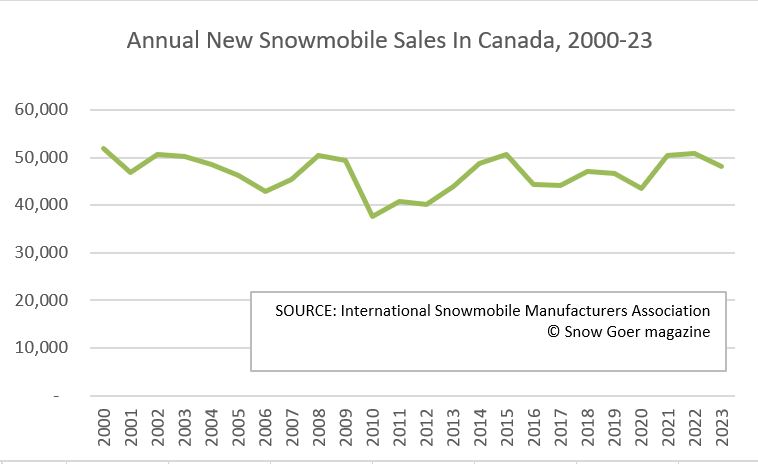
Sales of new snowmobile in Canada slipped 4.5 percent for the 2023 selling season. In real numbers, sales dropped from 50,943 in the 2022 season to 48,252 in 2023. It should be noted, though, that the 2022 numbers represented the highest number of new snowmobiles sold in Canada since the 2000 season.
Sales in Central Canada grew by about 400 units in 2023, the ISMA data shows, while sales dropped about 1,700 units in the East and about 750 in Western Canada.
The East still dominates Canadian sales, though. Paced by robust sales in Quebec, the East makes up 47 percent of Canadian sales. Central Canada accounted for 36 percent, with 17 percent is in the West.
Canadians registered their sleds in impressive numbers last winter. That figure jumped to 618,872 units compared to 601,601 machines the previous year, ISMA reported.
Mixed Bag Overseas
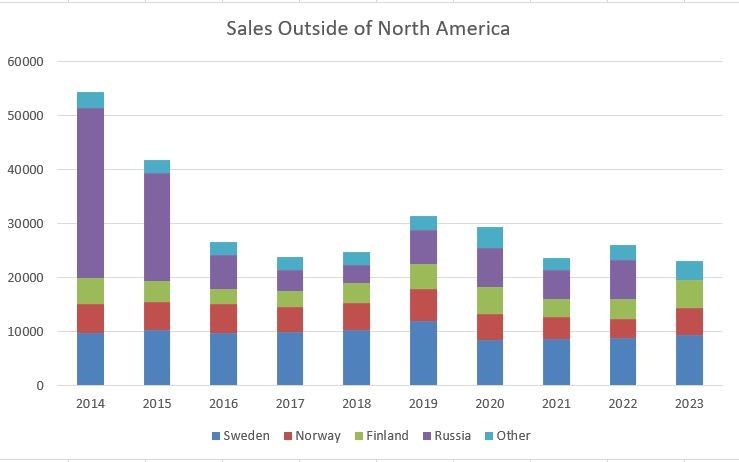
Vladimir Putin’s desire to overtake Ukraine against international desires has created plenty of headlines in mainstream media. It also reflected in international snowmobile sales figures. In fact, the disappearance of sales into Russia spoiled an otherwise rosy pictures of sales in northern Europe.
According to ISMA data, sales in Sweden were up 7.3 percent to 9,303 units in the 2023 sales season. Finnish sales jumped a whopping 39 percent to 5,205 new snowmobiles compared to 3,736 sleds the previous year. As a percentage, sales grew even more in Norway, where 5,037 new snowmobiles were retailed compared to 3,527 the previous year. That’s a 42.8 percent increase.
Sales by the big four manufacturers in other parts of the world also grew from 2,647 units to 3,419 machines.
However, sales of new machines from those brands into Russia went from 7,299 units in the 2022 season to zero last year. That was due to trade embargoes instituted after Russia’s invasion of Ukraine.
So, sales outside of North America were 22,964 units, an 11.3 percent decrease compared to the previous year.
Add all of it together, and you have a grand total of 124,769 retailed units. That’s a decrease of 4.5 percent or 5,875 units.


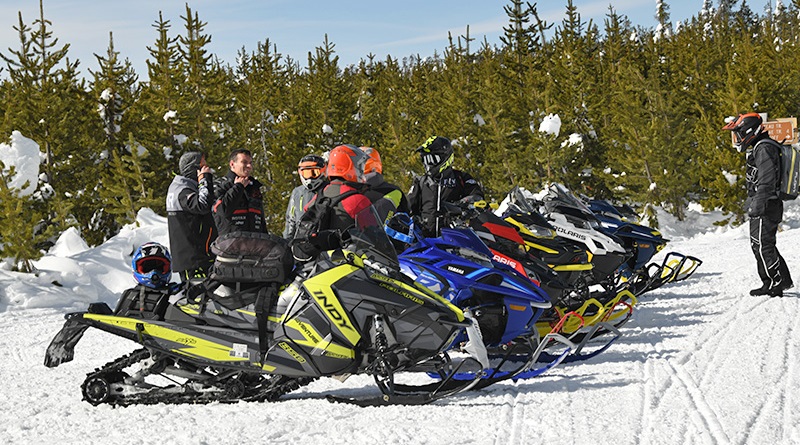

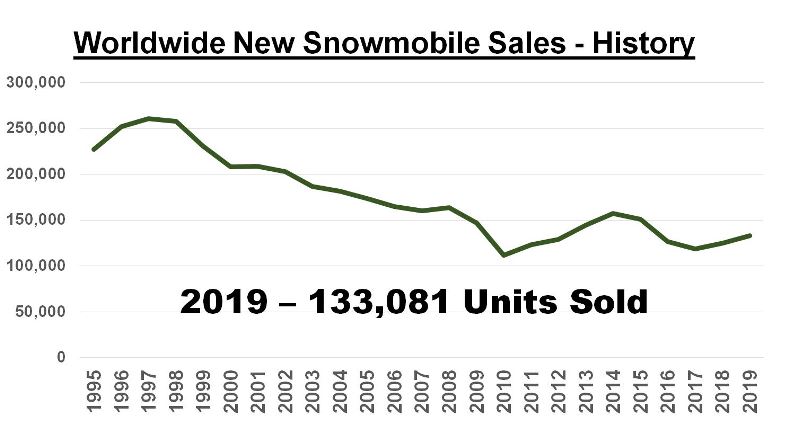
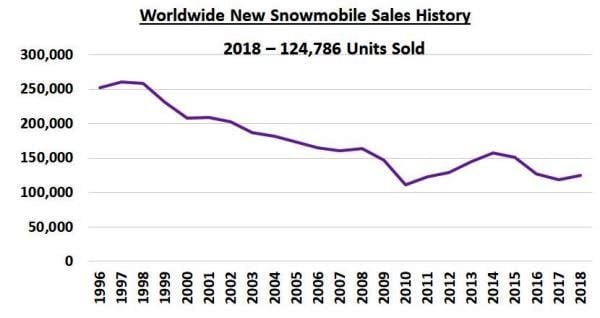
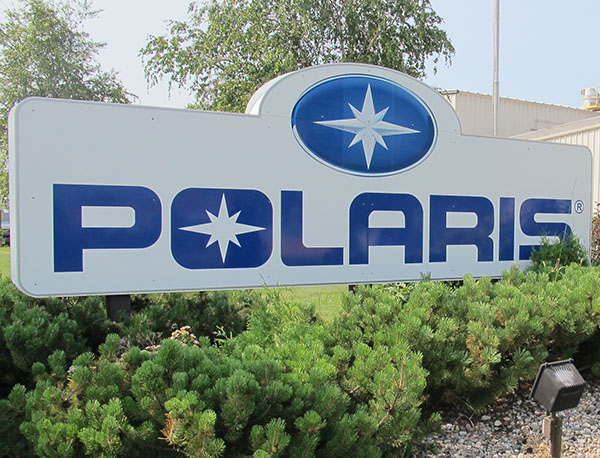
The new sleds are getting to expensive and gas and oil prices also . They are getting out of family budgets .
Due to manufactures greed to hike prices due to the pandemic and supply chain shortages overhyped, price of sleds has far out paced wage growth from the hey day of sled sales in 1968-1974.
We will never again have 600,000 sled sales a year for $800 sleds which were the market majority of sales. Those sleds now cost $17,000 – $28,000. People made $20,000- $25,000 back then and maybe double that now, So the crazy price jump of 21 – 35 times vs. a doubling of wages. I am speaking of Canadian prices and wages.
They keep raising the prices and the market keeps shrinking and many of the market now is fickle not like previous loyal long time riders in the 60’s-90’s. It was a family sport before of 3 generations riding (kids, parents and grandparents). Too much BS technology and making sleds unreliable too light and not durable and lasting like the triples of the 1990s lasting 20,000- 30,000 miles before a rebuild like all of my buddies (ex. XLT, Ultra).
Very sad. It was a great sport for the middle class and working class. Now just for the very rich.
I speak from experience of my family, friends, neighbors and class mates. I started riding in 1967. Many people friends family, neighbors had one two two sleds in the late 1960’s to mid 1970’s.. Most sleds around here were 250 – 440 cc sleds , mainly 292 -340 cc (15-35 hp). Biggest sleds of that time were 440 for the public, biggest race sleds were 600-800cc (60-80 hp). In the 1990’s most sleds were the 500-600cc (usually 580cc ~ 88 hp
Old sleds had to buy cleats and springs often and had to weld single cylinder mufflers and head shrouds in 1990’s it was usually just belts ($30), fuel filters ($2), and sliders ($20). Now a days parts prices are nuts $300+ belts, $160+ fuel filters, twin cylinders wear out fast especially 800 cc sleds way to expensive of a sport now due to less competition, too high prices. It was better when we had 200 manufacturers,so much choice to buy and where to buy from, department stores, local garages, sled dealers..
OEM’s are forgetting a nice small niche market…the small affordable machines. I still have a 1984 Ski-Doo Elan…a 250 cc, 12 hp and around 265 pounds. Talk about simplicity & reliability! My neighbour has a 1972 Elan and we go out in the forest. We open trails and have a blast. If you get stuck, you can lift the machines easlily and get running again in no time. In my area, there is a guy who has parts made in Asia and he can supply 75% of the parts. Take a look at the web sites still offering parts for Elans. Take a look at MarketPlace and see the numbers of old sleds being offered. If BRP were to reissue the Elan, they would sell a decent amount and be profitable at it. Please wake up!!! If only the new WideScape was more affordable, they could overtake this segment.
I agree 100% with you. Sometimes, these marketing people do not even ride snowmobiles! That is very scary.
Two great posts and points Pierre. 100% agree.
With premium fuel recommended now on most sleds that makes it even more out of reach of the average consumer. For example in Canada (central Parries) price is $6.80 a gallon for regular and $8 a gallon for premium it is way too expensive. If you do 300 miles a day of sled riding like I did and get 12-14 mpg that would be $200 in gas for the sled.
Add in 2 litres of oil plus gas for the truck if you are not riding from home and a restaurant meal on the trial ride this would add another $100 for a total of $300 a day per ride. So $1,200 a month for 4 weekend rides a month or $6,000 for fuel alone for a 5 month season. That is what a great sled in 1990’s cost.
Why make sleds which need gas which is 18% more than regular when the price is outrageous already? Gas is crazy high in price. i used to buy aviation gas 100 octane for my dirt bike in the late 1970’s and late 1990’s and it was expensive then but a small fraction of the price now.
Helmet prices are way to expensive used to be $30-$80 for a good helmet (1970-2000) now it is $800 over 10 times the price.
From what we used to ride 300 miles a day Saturday, 4 times a month, for 4-5 months of the year our annual gas bill now would be as much as we paid for our sleds in the mid to late 1990’s. Gas used to be a minor cost of the sport, not now it can be as much as 33% of the cost of the sled purchase, so in 3 years you pay as much in gas as you did for your new sled. The cost of the sport is totally out of touch of the average middle class family.
Sled sales are now basically 50 / 50 between US and Canada even though the US population is 10 times more than Canada. The US sales are dropping far faster over this period (1970 to now). 125,000 units for 400,000,000 total US and Canada population.
In 1970 Canada’s population was 21.4 million, the US was 204 million and we had 600,000 sled sales. Big factor was affordability of the sleds, the parts, the fuel and the fact that the target market was middle class and total family (3 generations). Now the target market is rich people and rich kids who are not die hard sled heads and not the outdoor type of people who are not sport or brand loyal.
Do what worked in the past make the sport targeted to middle class, drop the prices to have good trail performance sleds around $8,500 – $9,300.
The market was 250,000-260,000 sleds in 1997. So it shrunk by 50% in last 26 years.
The market was 600,000 in 1970 so it has shrunk by 500% in last 53 years.
I’ve worked in the industry for 20+ years “affordable” sleds don’t sell. All the manufacturers built them, but the market doesn’t want them.
Technology is what drives sales, the people who actually buy sleds want the newest, latest and greatest tech on their sleds. Look at what is selling it’s big cc, big power machines, with a large touchscreen gps. It’s not the blast, neo, or poo 550.
The people who complain that it’s too expensive, still complain that the low cost machines are under powered, don’t have enough features, or are too expensive.
Take your prices from the 70s and run them through an inflation calculator, then compare the technologies, complexity etc.
As far as reliably goes, that’s just rose colored glasses. Back then it was ride an hour wrench for two. Calling a 90s triple reliable is a joke. When was the last time you had to change plugs on the trail? Spark plugs have gone from being sold by the box of 10, down to only needed to be changed every couple of years
your so wrong …… i pick up used 90’s muscle sleds for a song, rebuild them, smoke anything on the trail for less than 1500 dollars after rebuild …. been on ski-doo since 1964, soon to celebrate 60 years on bombardier machines …… i laugh at this new stuff, cuz there are no mountains in my area ….. i call them bull-dozers …. 58 miles of wiring, cheese grader chasis’s, gotta pull the sled apart to change plugs, lean motors to pass epa …. 300 dollar belts …. ect. ~ all for 23k
That 1970 number is amazing and will never be touched — truly an amazing initial burst of energy for the market. But per your last figure, nothing can shrink by more than 100%. Call us math nerds, but that happens to be a pet peeve of ours. One manufacturer in particular is always making claims that whatever new gadget or part or whatever they have in any given year reduces vibration or noise or friction or whatever by 500% or 240% or whatever. But you can never reduce anything by more than 100 because then it’s all gone. Back to your initial comment, though, the market has definitely matured. The comments from Krom, though, are accurate – in the last 20 years, various “cheap” models have been introduced — Phazer, Freeride, Shift, etc. — and they typically languish in dealerships while all of the high-end sleds having waiting lines for people to buy them. We really, truly hope the current crop of Blast, Neo, Viper and EVO sleds reverse that trend and bring new people to our sport, but ultimately people are gobbling up 850 turbos and the like. It’s actually a more difficult problem to solve than one might think initially.
Hey guys. I have been in the sport for 55 years. I am a real sled head. Went to several races annually over the 55 years. Massive brochure, patches, hat magazine collection, be an avid sneek peak participant, had a manufacturer reach out to me for some research and thoughts and invited to test rides.
The meat of the market always was mid high performance eg. in 1970’s – 1980 340 cc, (eg. Colt, Charger, TX and TXL Indy) in mid 1990’s 580 – 680cc (XLT and Ultra). Not talking about Elan’s or NEO and other small size sleds you state.. Not talking cheap sleds just talking reasonable priced sleds, 1 to 3 sizes from the biggest.
If they made a sled like that again (eg. 100-130 hp 500-600 cc two stroke) at around $9,000 that would sell big. A good mid performance reliable sled no need for stupid expensive shocks or BS high tech gauges etc. Heck I did 300 miles on trails with my sleds (XLT and Ultra, still have my Ultra) on basic shocks rode 8-10 hour days with my buddies.
Sled prices have sky rocketed way past inflation and a gazillion times peoples average wages, look at my accurate statistic above. Need to go after the middle class market like thy did for the first 30 years of the sport. Ford makes a lot more money than Porsche because of that. It knows its roots and where the market is.
The market has shrunk to 1/5 of what it was. Look at the industry leading sleds of the day (never top of the line but always mid-high performance) Olympic, Colt, Mustang, Indy 500, Indy XLT all sales leaders by wide margins. 50% of the sleds sold in 1993 and 1994 were XLT’s. Notable mid performance sleds as well ET (250 & 300), Phaser 580, Indy Trail. All these sleds were the meat of the market.
Now manufacturers are building unreliable twins that have to be rebuilt way way too soon, have no grease zerks (my Polaris has 4 zerks), very costly parts prices and apparel.
My triples and my ridding buddy only changed plugs at most annually bu usually every 2- 3years. Never ever changed a plug on the trail. Have to warm up your sled properly on the stand and drive slow for the first 15 minutes or so and properly break in your sled and store in in covered area.
The reason the market has upscaled to rich people is because they keep hiking the price adding outrageous priced items socks, gauges, and fooling people in building lighter less durable and unreliable sleds is to make more money off of parts..
Again regular XLT, Ultra’s mine and others went 20,000+ miles on all original parts (except of course belts, sliders and oil line filters every 2,000- 4,000 miles). Ride on snow, and go in loose snow to coll down the sliders and the motor. I ride my sleds WFO often going 90-107 mph always put in Isopropenayl gas line antifreeze even with blended Canadian fuels..
People are not gobbling up 850 turbos just a few rich people with little no practical common sense, the reason why the market is only 20% of where it was. It is the only industry like that. The automotive market or motorcycle market has grown not shrunk like snowmobiles because they still market to middle class as well. The sled market has forgotten this they just focus on the most expensive sleds so their market will always shrink and eventually evaporate unless they go back to their roots i.e. first 30 years. I sure hope they wise up soon, get real riders back into the sport and executive offices and marketing positions. They need guys like Bob Eastman Yavone Duhalmel (spelling?) back in engineering, R&D and racing.
Meant 14 grease zerks vs none now a days, Makes no sense at all except for parts to wear out and be replaced by expensive parts that wear out far too soon. So easy to grease your sled after every few rides to keep it in great shape and not wear out (steering, suspension, drive and jack shafts), good quality idler and bogey wheels.
Again need good common sense sled guys like Bob Eastman (RIP) to talk sense to the manufacturers to build reliable good sensible priced sleds to average practical middle class people, regular folk who look after their belongings eg. who live in Roseau and Thief River Falls where the sleds are built, listen to your people on the production line who actually have history using your products vs. people in marketing and engineering who have no history or experience in the sport.
I am well off but I am not spending $30k on a sled. My current sled 2016 cat zr 9000 limited was on sale for $12,999 from $21,999 and I bought. I am a life long sledder but if prices don’t come down I’ll be in Florida instead of North Bay sledding
We know prices are a real consideration – trust us, we pinch every penny as tightly as we can around here!! That said, some people take the very highest-priced sled as proof that sleds are getting outrageously priced and then say they’re going to quit. Imagine doing that with other things: “You see the new Ferrari Monza costs $1.7 million. Cars are getting too expensive, I’m taking the bus from now on!” “You see that the mansion on Lake Watchmacallit just sold for $11.4 million?! Houses are getting too expensive – I’m getting an apartment!” Nobody says you HAVE to get a 850 Turbo with Smart Shocks, or a 200 HP four-stroke turbo with EPS and push-button control over your shocks… there are plenty of ways to enjoy our sport without getting the most devastating high-end product available. If you want the best of the best, you’ll pay more, just like anything in life. But don’t trick yourself into thinking that’s the only option to enjoy the best sport we know.
John not so. Look at all my posts and experience in the sport since 1968 look at my sales analysis since 1954-2024 sales models. It worked for the first 40+ years very well. It has not worked for the last 30 years. I know your bread and butter comes from the industry but you have to speak truth to power can’t be like Russian Generals lying to Putin look at what that is doing to Russia and Ukraine unimaginable harm because people are afraid to speak the truth. If you love the sport which I and everyone knows you do please try to solve the problem not defend the undefedandable. Please John. The status quo is the problem, it is not the answer.
FYI, seeing that you’re a Canadian, here are the official Intl Snowmobile Manufacturers Association figures for sales in Canada for the past 43 years. There have certainly been some peaks and valleys, no question, but the average over those 43 years has been 49,477… last year was 48,252, the year before 50,943.
Estimated Retail Sales
Canada
1980 63,000
1981 68,000
1982 49,000
1983 30,000
1984 33,000
1985 34,000
1986 37,000
1987 42,000
1988 46,000
1989 51,000
1990 57,000
1991 50,000
1992 51,665
1993 57,665
1994 58,418
1995 64,236
1996 66,717
1997 68,742
1998 68,618
1999 59,751
2000 51,995
2001 46,973
2002 50,719
2003 50,209
2004 48,556
2005 46,304
2006 42,953
2007 45,477
2008 50,556
2009 49,510
2010 37,670
2011 40,878
2012 40,165
2013 44,022
2014 48,758
2015 50,752
2016 44,431
2017 44,161
2018 47,024
2019 46,784
2020 43,535
2021 50,567
2022 50,943
2023 48,252
Hi John, Thanks for the info. I said the 1st 43 years were great 1954-1997 (the last big year for annual sales) and that the last 30 years were bad, you provided sales figures for the last 43 years not the first 43 years. Please report those annual worldwide numbers which shows explosive growth and the great years which are 3-6 times more than there are now or have been for the last 30 years.
John please provide the annual sales from 1954-1997 the good years (beginning to middle so far). especially in light of the fact that back in the late 1960’s and early 1970’s the snowmobile market was projected to easily exceed 1,000,000 units i.e almost 10 times what it is now as stated in the media. Now that is the information and story that we need to hear and learn from to correct the course the industry has been headed to for the past 30 years. Lets provide all the information so we can learn from history.
Right on Russ. You got a great sled for a great price. Many people agree with you and have let the sport.
What nobody else here has talked about is the real world inflation at about 50% for the kind of items middle class people buy every day (Food & Fuel)!!!!
It has left middle class consumers and snowmobile enthusiasts with empty pockets, that being the true reason the mid performance market isn’t out selling the top end machines.
I don’t think we can blame this on the snowmobile manufacturers, but more on green leftist legislation that plans to have 100% zero emission vehicles in Minnesota by 2040!! How does snowmobiling even survive this insanity.
Snowmobiling is still one of the cheapest motorsport hobbies. 20K for the acceleration of an 850 is cheap compared to cars, offroad trucks, sxs’s. Modern snowmobiles last 4x as long as sleds from the 90’s. Most buyers are buying performance models not the beginner to the sport sleds. A modern snowmobile you can ride 200 miles a day and not be sore. Try that on a 90’s sled. If you don’t like new buy used.
Modern sleds 800 and 850s do not last like 90s single pipe triples. I ride 300 miles a day on 97 Ultra and 94 XLT.
Having had the opportunity to participate in snowmobiling for decades, I share in fond memories of the “Good old days”. However we’re currently blessed with amazing comfort, technology, and reliability offered by the manufacturers. It’s unfortunate when a new sled breaks down (by no fault of the owner) but tune out the outspoken 1 in 1,000 on social media who have experienced an issue. I’d be bitter too but it can happen. Granted sleds, parts, and fuel are expensive but our modern machines are more capable, durable, and efficient. For example I recently replaced a drive belt that provided 4K miles of trouble free enjoyment. On our older sleds we would have had to buy at least 4 drive belts to travel as many miles and often needed to freshen up those old engines in that time. After accounting for inflation the cost per mile is now quite possibly less. Even our gear now provides greater comfort and protection. By grace the not so good old memories thankfully tend to fade away. Life on a sled has never been better than it is right now. Enjoy! P.S. Thank you for continuing to print SnowGoer magazine for us Old Timers.
Sorry my 95 XLT and & 97 Ultra Sp are far more reliable and durable than any modern area sled from 2000 up. I had 6,000 miles on the XLT and getting up on 14,000 on the Ultra no issues at all. I get 5,000 miles on belts and siders no issue just replace for no reason. No rebuilds at all. Ride them WFO 300 miles a day no issues at all on rough trails and ditches. C$ price for them new was 5.8K and 7.2K price has almost tripled now and they don’t last and nave zero zerks to grease vs. 14 on my sleds.
No one says to stop building the 850 turbos and four stroke turbos but need a sled 1-2 steps down with massively big savings to have a price in C$ of 9,000. The sport had great sales records in the 1960’s up to 1974. Heck even in 1997 they sold ~270,000 new sleds annually over twice as much as in the last decade. No other industry has had this decline. Not bikes, boats etc. they are all growing.
Make a modern day equivalent of and 94 XLT the best selling sled at the time by far, (only more powerful Polaris at the time was XCR 800 and RXL 650) or 97 Ultra SP (only bested by Polaris XCR 800 and XC 700 at the time) i.e a led 2 steps down from the top for massive savings. no high end rebuildable BS $2,000 shocks, just analog gauges, good mid size windshield for C$9,000, sales and profits will skyrocket and it will save and grow the industry to at least sales of 400,000 in the first year.
Said 94 XCR 800 meant Storm 800. Just thought likely a lot of readers (what I call newbies, new sled heads i.e. only 30 years experience) may not remember the Storms (750 and 800) or perhaps choose to forget them (800 triple triples from Polaris and Ski Doo had major recalls, not very durable, very low miles 1,500- 5,000miles before complete rebuild, similar to when 800 twins replaced them and even now, no where near the lifespan of a 600-700 twin or the great triple single pipe sleds that can’t be beat for reliability, durability, smoothness, power delivery, power output and of course that great sound. Three in a row makes to go go go.
The historical record speaks for itself. The market has clearly spoken. Sales have plummeted due to the high prices of sleds and lower reliability of sleds, lack of common sense common routine maintenance items deleted, sky high parts prices, getting away from DIY maintenance design. Name another industry where this has happened. Why aren`t the manufacturers listening.
I love the sport but am very sad and mad at how it has deteriorated due to greedflation. You have to base the price based on your historical market i.e. middle class buyers have to be in line with their average wages and cost of living.
Stop making excuses and offer solutions to explore to bring back our beloved recreational sport. The sales record speaks for itself and the reasons are clearly stated by my numerous posts and others posts. Annual sled sales are one fifth of what they were! It is time for a change to what worked in the beginning and middle past , not what is failing in the now and recent past 20 years. The numbers speak for themselves. Bring back the meat of the market, great performing sleds 2 down from the top performers with basic reliable durable low tech designs. Lets work together and not defend the undefendable. face facts and unite.
Keep the rubber side down, ride safe, ride sober, do not litter, respect private land, respect nature, respect people and animals request and right no loud aftermarket cans. Sledheads unite no matter your economic, social, political, religious, sex or race class. Lets all be PSCY+ (Polaris, Ski Doo, Arctic Cat, Yamaha and the 100+ past brands made).
The manufacturer’s have to create vehicles that excite people. If they create plane-jane vehicles that only work, but do not excite people, they won’t sell. All of the manufacturer’s have rooms full of people that study this stuff all day long and their numbers are showing the high end stuff sells. (Thankfully it trickles down and I can buy a 2020 Poo 800 anything for $8k right now.) If we as sledders (or ATV or boats or anything with a motor) don’t spend large amounts of money, the industry will go away. We have to spend money on this stuff or it will be gone. If a jug of synth oil is $80, it sucks, but that’s fine, because the alternative is riding an electric bike down the asphalt path I used to ride a sled down. We have to spend money, an uncomfortable amount of money, or this all goes away.
Obviously this has not worked when sled sales are 1/6 of what they were. The big sellers were always 2-3 steps down from top of the line ( Colt, Indy 500, XLT 580 any 600 cc sled) had reasonable windshield, standard shocks etc.
Go back to what works eg. 1960-1997 not the very poor sales from 1998-2024. I know I have been riding since 1968 and still have my original sled.
I have lost ~ 50+ riding buddies over the years because the sport is way out of line to what the market started out as and was for 40 years, just too expensive. Only one other sno mo buddy still regularly rides. Riding season is way shorter now as we used to start riding from Halloween or early November (now more like early January) and ended in mid April, now it can end in March. Climate change is here watch black gold to see how it was predicted by EXXON in early 70’s
https://watchseries.im/tv/watch-black-gold-full-81145
Sad day with Yamaha’s announcement today of getting out of the sled business. Clearly it is due to the huge massive decline in the sales since it hey day in 1960-1974 and the middle years of 1975-1997.
We were all better with 200 brands vs 4 brands now (soon to be 3) , completion means more health for the industry and for consumers and manufacturers. 1972 Chaparral had first consumer liquid cooled engine and later first IFS in race sleds.
I really liked Yamaha sleds and all of the innovation they brought (oil injection on first sled 25 years ahead of many other brands/models), powerful high performance and mid performance four stroke sleds, OHLIN shocks on sleds, winning with 440cc sleds vs other brands 800 cc sleds at Eagle River in the 1970’s, great funny TV ads Johnny Skeptical and Honey, great styling, VMAX4, Sales leader with ET SRV, SS 440, Phazer, awesome race sleds GPX, SSR. Yamaha was in first place for sales back when they knew the heart of the market small and mid sized fan and free air motors 250 – 540.
If the industry does not get back to its roots and grow AC will be next. Big time innovator
Lets all unite no mater your:
– Ethnicity (Polaris, Ski Doo, Arctic Cat, Yamaha, Rupp, MotoSki, SnoJet, Kawasaki, Suzuki, Harley Davidson, Mercury, Johnson, Evenrude, Aloutte, Chapparall, Viking,, John Deere, Ski Whiz, Scorpion, Roloflex, Norhtway, Skiroule, Ski Zoom, Sno Pony, Sno Prince, Areins, Eaton’s Sears, Manata, Raider, BLADE, etc.), PSCY+ = Polaris, Ski Doo, Arctic Cat, Yamaha, plus all the other former brands)
– Race (ovals, XC, SX, drag, watercross, hill cross, ditch, lake, river, freestyle)
– Colour (black, white, yellow, red, orange, blue, green, gold, purple,)
– Sex (2 stroke, 4 stroke, electric)
– Gender ( bore, stroke or magnet)
-Politics (ICM or electric)
Lets not lose another brand.
Johnny and Bunny, not honey, sorry.
PSCYL+, forgot Lynx. But I guess it will be PSCL starting in 2025 but really is only PSC.
I guess to be truly politically correct or woke should also talk about sled pronouns:
Snowmobiler
~biler
Sledder
Sledhead
SkiDooer
snowmachiner
powertobaggoner
Happy Canada Day (July 1) and July 4th to everyone.
Ok here are the dates the big 4 started making sleds and sled sales trends.
Polaris 1954. So model year 24 is 70 years in the business.
Ski Doo 1959. So model year 24 is 65 years in the business.
Arctic Cat 1960. So model year 24 is 64 years in the business.
Yamaha 1968. So model year 24 is 56 years in the business.
Sleds have been around for 70 years. Highest sales were in 1970. There were over 100 brands / manufacturers.
It only took 16 years to go from 0 sales to 600,000 units a year and from 1 manufacturer to 100+! Phenomenal success and growth rate!
Sleds from 1954 – 1970 were marketed to working class to middle class families and that is where almost all of the sales were. Most sales were in the low to middle to two models down from the top (650 and 800 cc) of the line sleds in terms of power, speed and price eg. 250 cc fan-cooled single cylinders to 440cc twin free airs. Top sleds were 800 cc free air twins eg. TX and TNT and of course 800 cc triples and quad King Cats.
Sleds from 1971-1980 were the same but oil crisis hit in 1974 and 1980 recession sled sales were drastically reduced and most manufacturers went out of business.
Sleds from 1974-1997 meat of the market was small sleds 250 cc fan cooled to 580 cc single pipe liquid cooled triples. Top of the line sleds again were 800 – 900 cc triple triples. Majority of the market then was 500 cc twins to 580 single pipe triples. 1997 sales were 270,000.
For the first 43 years including last big year of sales 1997 close to 300,000 units annually from the sales record of 600,000.
Last 27 years sales have fallen to 100,000 units because the marketing focus is on unreliable top end 800/850 twins with crazy high sled and parts prices and unnecessary focus on light weight, no routine DIY maintenance, expensive shocks , digital gauges, turbos and ultra lean fuel injection and oil injection settings. Went from 100+ manufactures to 3 with 5 brands.
Any way you look at it the last 30 years have been a complete failure, the numbers do not lie. Time to go back to the phenomenal success market focus in the first 16-43 years 1954-1997.
I was disgusted at the price increases of new sleds in ‘23 and then the ‘24 models. I’m out. I will not buy the over priced, over complicated, unreliable sleds they are manufacturing today. I fit exactly into the key demographic they market sleds to. They are losing me as a customer and I’ve been snowmobiling continuously since the mid 80’s. I’ll continue to ride but I can’t justify spending what they are asking for a performance 600cc trail sled. The 850cc sleds have junk motors that don’t last. I then look at how much further my money goes with buying a dirt bike or ATV. Those machines run for years and years and years. Ever swap an engine out on a modern CFI Polaris? It sucks!
Modern sleds have all the complications of automobiles and none of the reliability. I laugh at whoever commented that modern sleds are more reliable than 90’s sleds. Take a look around at what older sleds are still running on the trails. They aren’t the first generation of modern EPA compliant, lean burn fuel injected sleds.
100% agree with you XCR600.
Back in the late 1960’s and early 1970’s the snowmobile market was projected to easily exceed 1,000,000 units i.e almost 10 times what it is now as stated in the media.
John, Thanks for the info. I said the 1st 43 years were great 1954-1997 (the last big year for annual sales) and that the last 30 years were bad, you provided sales figures for the last 43 years not the first 43 years. Please report those annual worldwide numbers which shows explosive growth and the great years which are 3-6 times more than there are now or have been for the last 30 years.
John please provide the annual sales from 1954-1997 the good years (beginning to middle so far). especially in light of the fact that back in the late 1960’s and early 1970’s the snowmobile market was projected to easily exceed 1,000,000 units i.e almost 10 times what it is now as stated in the media. Now that is the information and story that we need to hear and learn from to correct the course the industry has been headed to for the past 30 years. Lets provide all the information so we can learn from history.
Snowmobile sales likely will have a boost in late 2023 and in 2024 due to the Barbie movie in which a snowmobile is one of the five transportation methods need to cross from Barbie-land to the real world and from the real world back to Barbie-land. 1956 Corvette, tandem bike, rocket ship, speed boat, snowmobile and barbie camper.
With interest rates having increased I suspect there will be quite a few unclaimed snowcheck sleds at dealerships this fall. I just checked and the price of a Polaris EVO jumped $2000 from $6000 in ‘20 to $8000 for a ‘24. That is insane! It’s the same fricking sled. That is pure greed by the OEM and I hope they get stuck with a bunch of carry over this season.
The sled market is broken. Pretty bad when even Yamaha finally pulls the plug and bails on this segment. But yeah, the snowmobile press will continue to hype that everyone needs a turbo 850 and some expensive gauge so you can receive your text messages and swoon over every new bell and whistle they include on new sleds even though they are unnecessary. All that junk adds costs. The marketing machine keeps advertising to the smaller and smaller boomer demographic and they can’t recognize they are in a death spiral.
The motorcycle industry recognizes this and is starting to produce more and more small displacement, lower priced bikes that are fun and offer good performance. Harley doesn’t see it that way and continues to bleed money. The sled OEM’s are Harley Davidson right now.